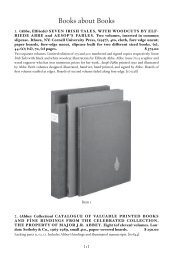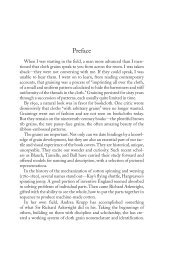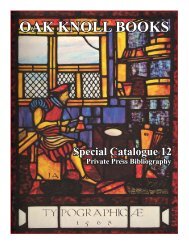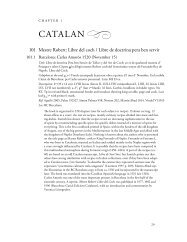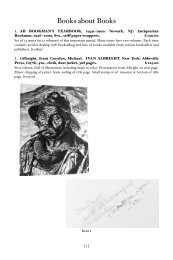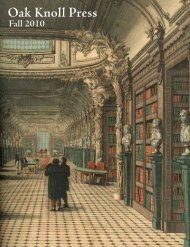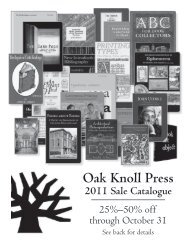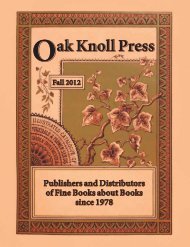View Excerpt (PDF) - Oak Knoll Books
View Excerpt (PDF) - Oak Knoll Books
View Excerpt (PDF) - Oak Knoll Books
You also want an ePaper? Increase the reach of your titles
YUMPU automatically turns print PDFs into web optimized ePapers that Google loves.
29<br />
2 The Creation of a Business,<br />
1724–1797<br />
On 4 August 1724, a precise date (old style), Thomas Longman I paid<br />
precisely £2,282 9s. 6d. (also old style) for the bookselling and publishing<br />
business of William Taylor, who had traded under The Sign of the Ship in<br />
London’s Paternoster Row. 1 Taylor had died of ‘a violent fever’ in May 1724,<br />
and Longman, born in Bristol and then 25 years old, bought the business<br />
from Taylor’s executors, John Osborn(e) and William Innys. 2 He was in a<br />
position to do so because four years earlier at the age of 21 he had inherited<br />
his father’s and some of his mother’s West Country properties. He had<br />
finished his apprenticeship on 9 June in 1723, and he was to be made a<br />
Freeman of the Stationers’ Company on 6 October 1724.<br />
‘The Row’, situated in the parish of St. Gregory, a narrow street, little<br />
more than a passage, was then a lively place of activity for booksellers, publishers,<br />
authors and, not least, readers. There had already been booksellers<br />
there – along with mercers, silk men and lace-makers – in the reign of<br />
Queen Elizabeth I. 3 Indeed, even before the invention of movable printing<br />
type in the fifteenth century, the first great modern invention in the history<br />
of communications, there had been scriveners there, people who wrote on<br />
parchment, working alongside the makers and sellers of rosaries. 4 The area<br />
The title page to the second part<br />
of Ussher’s Annales (1650–54)<br />
published by John Crook. The<br />
volume carries the device of a<br />
ship in full sail, its first known<br />
use on a title page. James Ussher,<br />
a scholar (who also became the<br />
Archbishop of Ireland in the<br />
Church of Ireland) wrote this<br />
monumental work towards the<br />
end of his life, his purpose<br />
being to give the date of the<br />
foundation of the world<br />
Longman Archive Pt II 55/2<br />
1 The reformed Gregorian calendar was not adopted in England until 1752. In<br />
old style the year was reckoned as beginning on Lady Day, 25 March. ‘Give us<br />
back our eleven days’ was a popular cry of protest at the moment of change. A<br />
monetary decimal system was not introduced until February 1971.<br />
2 Taylor was described in Read’s Journal, 9 May 1724, as ‘an eminent bookseller,<br />
reputed to be worth between 40 and 50,000 pounds’. Innys, who published<br />
at The Sign of the Princes Arms from 1711 to 1732, married Taylor’s widow in<br />
1725. (London Journal, 16 Jan. 1725.)<br />
3 See J. Stow, Survey of London (1598; revised and enlarged edn., 1603). For a<br />
seventeenth-century visit to Paternoster Row to buy not a book but a waistcoat,<br />
see Samuel Pepys’ Diary, 21 Nov. 1660. In 1720 John Strype, A Survey of the<br />
Cities of London and Westminster (Book 3, p.195) in two volumes provided an<br />
invaluable supplement to Stow when he discussed old Paternoster Row.<br />
4 W. Harvey, London Scenes and London People (1863); ‘Aleph’, Paternoster Row<br />
and the Chapter Coffee House (1864); T. Rees and J. Britton, Reminiscences of<br />
Literary London from 1779 to 1853 (1896), Part I, Paternoster Row. For an older,<br />
colourful popular description of the early and later history of the Row, with<br />
illustrations, see Pinnock’s Guide to Knowledge, 2 Aug. 1834. For Rees and<br />
Britton’s association with Longman, see below, p.58.
30 A HISTORY OF LONGMANS AND THEIR BOOKS 1724–1990<br />
From a map of Farringdon<br />
Within Ward, 1720 by Richard<br />
Blome (fl. 1720–1755)<br />
Guildhall Library, City of London<br />
round St. Paul’s Cathedral was not, however, London’s only bookselling<br />
centre in the late seventeenth century. Two others were located around<br />
the Law Courts and in ‘Little-Britain’, off Smithfields, and there were<br />
booksellers operating in other places, including Bishopsgate Street and<br />
Tower Hill.<br />
A late-seventeenth-century description of the ‘Little-Britain’ area by<br />
the lawyer and writer Roger North successfully catches the atmosphere of<br />
bookselling as it must also have been somewhat later in the Row. What North<br />
called ‘a mighty trade in books’ drew large numbers of people, including<br />
‘learned authors’, to the bookshops ‘as to a market’, but buying was not the<br />
only activity. There was ‘agreeable conversation’ there too. ‘The booksellers<br />
themselves were knowing and conversible men, with whom, for the sake of<br />
bookish knowledge, the greatest wits were pleased to converse.’ 5<br />
The adjective ‘bookish’ at that time had few adverse connotations.<br />
And it was books themselves that did much to focus images of the Row that<br />
shaped perceptions of both bookselling and booksellers. A characteristic<br />
example was W. Harvey’s London Scenes and London People (1863), which<br />
described ‘booksellers and publishers of modern times’ as ‘the best<br />
patrons of literature’ who rewarded their authors with ‘both hands, if their<br />
5 GM, Vol. 50 (1780), p.20.
THE CREATION OF A BUSINESS 31<br />
headwork deserves it’. 6 Folklore clustered. ‘The Row [became] legible’ as a<br />
palimpsest ‘not only through … the physical reality of the buildings, but<br />
from the remembered and the memorialized’. 7 There was a rich literature<br />
on the Row, easy of access in both shops and libraries. ‘<strong>Books</strong>talling’,<br />
exploring the bookstalls, was an agreeable diversion as W.R. Roberts<br />
described it in The Book Hunter in London. One of his illustrations was<br />
Paternoster Row on a Bank Holiday. 8<br />
The unforgettable Great Fire of London in 1666, chronologically the<br />
first of several fires to figure in this History, destroyed the Great Hall of the<br />
Stationers’ Company and huge amounts of neighbouring property, much of<br />
it in the hands of leaseholders. 9 It did not obliterate all old boundaries, but<br />
it changed the appearance of the area around St. Paul’s, destroying along<br />
with the old Cathedral St. Gregory’s Church which had been attached to<br />
its south-west corner. 10 In the new development that followed, the building<br />
of Christopher Wren’s new cathedral, a protracted process, the cathedral<br />
6 Harvey, op. cit. , p.214, where he described ‘the flight of fashion’ from the Row.<br />
‘What a changeable world we inhabit … think of beaux and belles resorting<br />
thither on foot to purchase their gay clothes’.<br />
7 J. Raven, ‘Memorializing a London <strong>Books</strong>cape: The Mapping and Reading<br />
of Paternoster Row and St. Paul’s Churchyard, 1695–1814’ in R. Alston (ed.),<br />
Order and Connection (1997), p.179. Raven has meticulously mapped and<br />
analysed details of occupation and ownership, following in the wake of P.W.M.<br />
Blayney, The <strong>Books</strong>hops in Paul’s Cross Churchyard (Occasional Papers of the<br />
Bibliographical Society, No. 5 (1990) and his work has been continued by Nigel<br />
Hall. See also Raven’s ‘Constructing <strong>Books</strong>capes: Experiments in Mapping<br />
the Sites and Activities of the London Book Trades of the Eighteenth Century’<br />
in J. Murray (ed.), Mappa Mundi: Mapping Culture/Mapping the World (2001),<br />
pp.35–39, his ‘The Book Trade and the Precinct’ in A. Burns and D. Keene<br />
(eds.), The History of St. Paul’s Cathedral, 600–2004 (2004), and ‘The Book<br />
Trades’ in I. Rivers (ed.), <strong>Books</strong> and their Readers in Eighteenth Century England:<br />
New Essays (2001), pp.1–34.<br />
8 W.R. Roberts, The Book Hunter in London (1895), p.209.<br />
9 Pepys described in his diary (26 Sept. 1666) ‘the great loss of books in St.<br />
Paul’s Churchyard and their Hall also’: John Evelyn claimed that many<br />
businesses survived the Fire without great loss: ‘only the poor booksellers<br />
have been indeed ill-treated by Vulcan’. Most of the records of the Stationers’<br />
Company were preserved.<br />
10 Tom Fuller wrote that St. Paul’s may be called the Mother Church, having<br />
one babe in her body (St. Faith’s in the crypt) and another in her arms (St.<br />
Gregory’s). For the ‘Great Fire’ see J. Bedford, London’s Burning (1966), and<br />
for the rebuilding of London and the range of regulations associated with it<br />
see T.F. Reddaway, The Great Fire of London (1951 edn.) and P.E. Jones and T.F.<br />
Reddaway (eds.), The Survey of Building Sites in the City of London after the<br />
Great Fire of 1666 by Peter Mills and J. Oliver, 5 vols. (1962–7).
32 A HISTORY OF LONGMANS AND THEIR BOOKS 1724–1990<br />
dominated the cityscape from the time of the laying of its foundation stone<br />
in 1675. The Choir was completed by 1697, and in 1710 the great dome,<br />
which stood out above all the buildings around as it was to do until the<br />
fierce fires of the Second World War.<br />
It was during the reign of Queen Anne (1702–1714) that the St. Paul’s<br />
area became ‘the greatest book mart in the world’, and from the start there<br />
was a physical contrast between the open churchyard of the cathedral and<br />
the hidden haunts of booksellers and book buyers, the kind of contrast<br />
that engenders legend. 11 Each of the houses in the narrow street had its<br />
secrets. Many of the houses were small with narrow frontages, but some<br />
were surprisingly large. Leasehold was the most common form of property<br />
tenure, and there were frequent changes of tenure and of trading. Sometimes<br />
books were sold on their own: frequently other items were sold too. 12<br />
When Thomas acquired his new business in 1724, the substantial<br />
purchase price that he paid for what was a successful going concern in<br />
the Row covered Taylor’s household goods as well as his stock-in-trade, his<br />
books ‘both bound and in sheets’, and his premises, shop and warehouse.<br />
Taylor, ‘a man of capital, respectability and position’, 13 had occupied two<br />
adjacent properties with different histories – one at The Sign of the Ship in<br />
Paternoster Row and the other at The Sign of the Black Swan, at the corner<br />
of Paternoster Row and Ave Maria Lane. Both Signs were to be used by the<br />
House of Longman, the former far more frequently.<br />
The property at The Sign of the Ship had been described in a twentyone-year<br />
lease of 1667 as a ‘good and sufficient house in accordance with<br />
the Act of Parliament for rebuilding the City’. 14 The property at The Sign<br />
of the Black Swan had been a separate bookshop until 1719 when Taylor<br />
acquired the remaining lease of it from the influential bookseller and<br />
publisher Awnsham Churchill after the death of his brother and partner<br />
John. Praised as a bookseller ‘well furnished for any great undertaking’,<br />
Awnsham, who never married, was from 1705 to 1710 Member of Parliament<br />
for Dorchester, where his father had been a bookseller. 15 Awnsham’s brother<br />
11 C.H. Timperley, A Dictionary of Printers and Printing with the Progress of<br />
Literature, Ancient and Modern (1839) and his Encyclopaedia of Literary and<br />
Typographical Anecdote (1842), largely a second edition of his earlier work.<br />
12 James Raven, The Business of <strong>Books</strong>: <strong>Books</strong>ellers and the English Book Trade<br />
1450–1850, (2007) pp.28, 116–7, 177.<br />
13 The Critic, 24 March 1860, p.366.<br />
14 Before the Great Fire there had been a building on the site called the ‘Cherry<br />
Tree’ and later the ‘Cross Keys’.<br />
15 J. Dunton, The Life and Errors of John Dunton, Late Citizen of London written<br />
by himself in Solitude (1818 edn.), p.204. For Dunton, a lively but challenging<br />
source, see SOB, Ch.II, and below, pp.112–3. See also H.R. Plomer, A Dictionary<br />
of the Printers and <strong>Books</strong>ellers who were at Work in England, Scotland and Ireland<br />
from 1668–1725, Vol. 2, (1922), pp.69–70.
THE CREATION OF A BUSINESS 33<br />
John had acquired the lease of the Black Swan for 21 years in 1714, and on his<br />
death it passed into Awnsham’s hands. The Churchills were the publishers,<br />
inter alia, of William Camden’s Britannia and of John Locke’s Essay Concerning<br />
Human Understanding.<br />
~<br />
The pre-Longman history of ‘At The Sign of the Ship’ leads back deep into<br />
the seventeenth century before the Great Fire. While Thomas Longman<br />
was a new recruit to the book trade, the business that he acquired was<br />
already old in 1724. Long before the Taylors, ‘At The Sign of the Ship’ had<br />
been seen over a London bookseller’s shop in 1640 in the Churchyard<br />
of old St. Paul’s. The owner, John Crook(e), who had started as a London<br />
bookseller in 1638 at The Sign of the Greyhound (not a new sign), also in St.<br />
Paul’s Churchyard, offered his customers ‘all manner of books … brought<br />
from beyond the seas’, by which he meant books from across the Irish Sea,<br />
not very far away, where he played an important role as a printer. 16<br />
In 1660 Crook(e) was appointed Printer General in Ireland, with power<br />
to print all books and statutes, but he continued to trade in London also,<br />
and when his shop was destroyed in the Great Fire, he moved temporarily<br />
to Duck Lane, a small street leading out of Smithfield, under a different<br />
but related Sign, that of the Anchor. 17 The last book which he published<br />
was The French Gardiner, ‘Englished by John Evelyn’. His finest book, a<br />
magnificent folio of Archbishop Ussher’s Annals (1650–54), incorporated a<br />
device of a ship in full sail with a Latin imprint on the woodcut Sub Insigne<br />
Navis in Cemeterio Sancti Pauli.<br />
After Crook(e) died in 1669, leaving a widow but no will, his former<br />
apprentice, Benjamin Tooke, also connected with Ireland, took over his<br />
business; and in 1670, during the rebuilding of London after the Great Fire,<br />
he moved the Sign of the Ship back to St. Paul’s Churchyard. Tooke was a<br />
substantial publisher who held shares in many publishing undertakings,<br />
including the works of Jonathan Swift, and it was Swift who helped him to<br />
secure the title of Printer to the Queen in 1713. Active in the affairs of the<br />
Stationers’ Company, Tooke died in 1716, leaving his business to his son,<br />
also called Benjamin. 18<br />
In 1687, however, Tooke had sold his Churchyard shop to William<br />
Taylor’s father, John, who traded there until 1706. The son of a Sherborne<br />
clothier, John was described by Dunton as an honest, industrious and<br />
The title page of the third<br />
edition of The French Gardiner,<br />
‘Englished by John Evelyn’, 1675<br />
BL 1506/225 (1)<br />
16 For reference see Plomer, op. cit., Vol. 1, 1641–1667 (1907), p.11.<br />
17 No ships are portrayed in R.B. McKerrow, Printers’ and Publishers’ Devices in<br />
England and Scotland, 1485–1640 (1913), although there were several anchors.<br />
18 Tooke held many Stationers’ Company offices. From 1687 to 1702 he was<br />
Warehouse-Keeper of the Company and in 1688/9 Junior Warden. He was<br />
Treasurer from 1677 to 1702.
34 A HISTORY OF LONGMANS AND THEIR BOOKS 1724–1990<br />
These trade sale catalogues<br />
show how a bookseller could<br />
build up his list at auctions<br />
of the stock and copyrights of<br />
other booksellers<br />
BL Cl.70aa.1<br />
obliging man with ‘moderate principles’. 19 In 1703 he instituted an annual<br />
sermon at the Baptist church in Lincoln’s Inn Fields to commemorate his<br />
escape from death in the great storm of that year. Taylor had previously<br />
traded successfully under The Sign of the Globe at the west end of St.<br />
Paul’s Churchyard, and for a time he worked in partnership with his son<br />
William, who had served his apprenticeship with him. The last book of his<br />
to bear the Globe imprint was The Female Advocate, A Poem written by a<br />
Lady in Vindication of her Sex (1686). By a coincidence, the last of his books<br />
bearing the Ship imprint was The Husbandman’s Disputation (1706).<br />
In 1711 William Taylor, who for four or five years had been operating<br />
on his own account, moved The Sign of the Ship, by now a ship in full<br />
sail, around the corner from St. Paul’s Churchyard into the premises in<br />
Paternoster Row that Thomas Longman I was to buy. A catalogue of books<br />
printed for him ‘At the Ship’ includes John Donne’s poems as well as Lex<br />
Mercatoria: Or the Laws relating to Merchants and The Best Way to be Wise<br />
and Wealthy: Or the Excellency of Industry and Frugality. In less serious<br />
vein, the list included The Tunbridge Beau’s Love Letter and The Epsom Lady’s<br />
Answer. The catalogue list was headed with a Ship colophon: the first of his<br />
books to bear a Ship colophon had appeared in 1707 while he was still<br />
operating from St. Paul’s Churchyard. It was an edition of the Book of<br />
Common Prayer with paraphrases of the Psalms.<br />
~<br />
These were stirring times, when religion and politics were inextricably<br />
intertwined on both sides of the Irish Sea and when there was a brisk<br />
demand both for pamphlets and for news concerning both. They were<br />
years of strategic importance, therefore, in the history of the periodical and<br />
of the newspaper as well as in the history of the book. 20 In 1688 William<br />
and Mary had succeeded James II, who fled abroad, and the Battle of the<br />
Boyne in Ireland, which was to pass into legend as well as into history, was<br />
won by the Protestants in 1690. Religion and politics were intertwined also<br />
on European soil during the long War of the Spanish Succession, which<br />
began in 1702 and did not end until the Peace of Utrecht in 1713. William<br />
died in 1702, and the reign of Queen Anne was shaped not only by foreign<br />
conflict but by a ‘dreadful Spirit of Division’ in Britain itself which also<br />
found ready expression in books.<br />
According to Joseph Addison (1672–1719), writing in 1711 in The<br />
Spectator, a periodical which did much to proclaim the ‘civilising culture’<br />
of the book (and of the essay), ‘as men formerly became eminent in<br />
19 Dunton, op. cit., p.207.<br />
20 Dunton (ibid., pp.2110–11) referred to Roper, a former partner of his, who<br />
printed the Postbag and The Annals of Queen Anne, and to John Salusbury, ‘a<br />
desperate Hypergorgonic Welshman’ who printed The Flying Post.
THE CREATION OF A BUSINESS 35<br />
learned Societies by their Parts and Acquisitions, they now distinguish<br />
themselves by the Warmth and Violence with which they espouse their<br />
respective Parties.’ 21 Preceded by The Tatler, 1709–11, edited by Richard Steele<br />
(1672–1729), it referred to the ‘perusing’ of a book in its first sentence. 22 This<br />
was the first great expansionist phase in the history of the book in times<br />
when the ‘ubiquity of print’ came to be taken for granted.<br />
Expansion had preceded the lapse of the licensing system in 1695,<br />
a landmark date. If ‘something of a legislative accident’, as it has recently<br />
been called, since the lapse followed differences between the Commons<br />
and the Lords on the wording of any new legislation to replace the old,<br />
nevertheless, according to Macaulay, it did more for liberty and for<br />
civilisation than the Great Charter or the Bills of Rights’. 23 The licensing<br />
system had been in operation (with a break between 1679 and 1685) since<br />
1662 – and had replaced earlier executive decrees going back to 1557, the<br />
year when the Stationers’ Company was founded. The Company was no<br />
longer in full control of the process, although it maintained intact many of<br />
its controls, among them its apprenticeship system. 24<br />
Whatever their background or attributes, all book trades apprentices<br />
were required to advance by the same route, learning from practice ‘the<br />
Mysteries of the Trade’. They also had to follow its ‘Customs’. Boys were<br />
expected to be fourteen years old when they began their apprenticeship, and<br />
Masters had to show that they were Freemen of the City of London as well<br />
as the Company. Yet as late as 1757, John Nichols, the source of much of<br />
our knowledge of publishing, was apprenticed before he was ‘quite thirteen’,<br />
and Thomas was older than the average. 25 As an orphan too, Thomas was<br />
outside the trend. The number of fatherless apprentices fell by forty per cent<br />
between the first and the last decades of the century.<br />
By then the business side of ‘publishing’ was more openly apparent to<br />
the world than it had been when Daniel Defoe (1660?–1731), a prolific as well<br />
as a perceptive writer, published his treatises, along with pamphlets and a<br />
Engraving of John Nichols,<br />
(1745–1826), author of Literary<br />
Anecdotes of the Eighteenth<br />
Century in nine volumes<br />
(1812–15)<br />
Longman Archive<br />
21 The Spectator, No. 125, 24 July 1711. The Spectator was launched in March 1711.<br />
22 Both Steele and Addison were keen social observers as well as readers. T.B.<br />
Macaulay believed that if Addison had written a novel it would have been<br />
‘superior to any that we possess’. (Literary Essays (1923 edn.), p.651.)<br />
23 J. Brewer, The Pleasures of the Imagination, English Culture in the Eighteenth<br />
Century (1997), p.131; T.B. Macaulay, The History of England from the Accession<br />
of James II, 2 vols. (1948), Vol. 2, Ch. 21. See also R. Astbury, ‘The Renewal of<br />
the Licensing Act of 1693 and its Lapse in 1695’, in TL, 5 th series, Vol. 38 (1978),<br />
pp.296–337.<br />
24 Raven, The Business of <strong>Books</strong>, op. cit., pp.65–8, 85–8, 201–4.<br />
25 J. Nichols, Literary Anecdotes of the Eighteenth Century, Vol. VI (1815), p.628. For<br />
Nichols see above, p.11.
36 A HISTORY OF LONGMANS AND THEIR BOOKS 1724–1990<br />
Frontispiece (which includes<br />
a ship) and the title page of<br />
The Life and Strange Surprizing<br />
Adventures of Robinson Crusoe<br />
of York, Mariner by Daniel<br />
Defoe, Taylor’s edition (1719)<br />
BL C.30.f.6.<br />
Review as well as fiction. His fiction, Ian Watt observed in his pioneering<br />
study of the English novel in 1957, is the first that presents us with a picture<br />
both of the individual’s life in its larger perspective as an historical process<br />
and with a closer view ‘which shows the process being acted out against<br />
the background of the most ephemeral thoughts and actions’. 26 Yet Defoe<br />
did not refer to his own works as ‘novels’ and he denied that he was writing<br />
‘fiction’. 27<br />
A study of him, traveller as well as writer, was to appear in 1856 among<br />
the first fifty volumes of Longman’s Travellers’ Library, an ambitious new<br />
26 I. Watt, The Rise of the Novel (1957), p.24, subtitled Studies in Defoe, Richardson<br />
and Fielding. Subsequently much has been written about eighteenth-century<br />
novels from many different angles. For contemporary comment see I.<br />
Williams (ed.), Novel and Romance, 1700–1800: A Documentary Record (1970).<br />
For retrospective narrative and analysis see L. Davis, Factual Fictions: The<br />
Origins of the English Novel (1983); G. Day, From Fiction to the Novel (1987); M.<br />
McKeon, The Origins of the English Novel (1987); and J. Paul Hunter, Before<br />
Novels (1990).<br />
27 See E. Zimmerman, Defoe and the Novel (1975); J.J. Richetti, Defoe’s Narratives:<br />
Situations and Structures (1975); P. Earle, The World of Defoe (1976); P. Rogers,<br />
Robinson Crusoe (1979); and G.M. Sill, Defoe and the Idea of Fiction, 1713–1719<br />
(1983).



